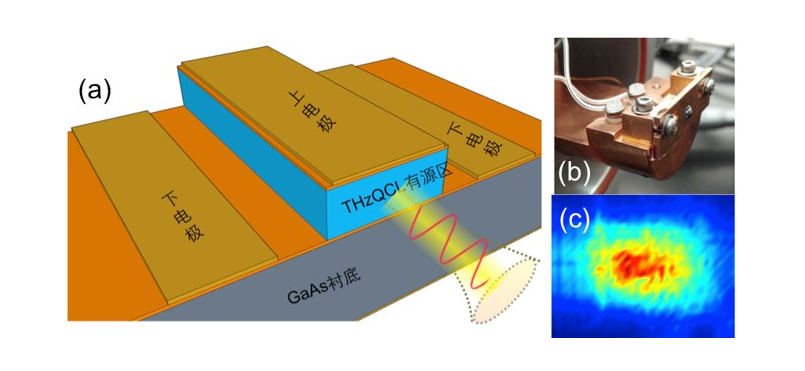Terahertz photonics technology: Material, Device and Application
Date:09-06-2017 | 【Print】 【close】
Aiming to satisfy the national strategic demands, the laboratory carries out fundamental and perspective research on terahertz science and technology. The main research directions include: (1) Semiconductor material for optoelectronic devices; (2) Terahertz lasers and detectors; (3) Terahertz communications and imaging system; (4) Terahertz physics and cutting-edge technologies.
The laboratory has developed the innovative theoretical method and self-owned intellectual property technologies in the modelling, material growth, device fabrication, and applications of terahertz quantum cascade lasers (QCLs). The active region of terahertz QCLs are grown by using a gas-source molecular beam epitaxy. The fabricated terahertz QCLs have a frequency spanning from 2.5 to 5 THz, a maximum peak power of 1.2 W. Based on the high performance terahertz QCLs, we developed the terahertz imaging system with a spatial resolution of 0.5 mm; jointly developed the real time terahertz imager, and terahertz scientific equipment for simultaneously performing imaging and spectroscopic measurements. The research was supported by the Major National Development Project of Scientific Instrument and Equipment. The laboratory also developed the compact terahertz QCL module which are then provided to domestic and oversea clients for local oscillator and terahertz imaging applications.
Terahertz quantum well photodetectors (QWPs) are able to respond to the terahertz light between 2.5 and 7 THz. The terahertz QWP has various properties, such as small volume, highly sensitive, fast response and so on. The laboratory designed terahertz QWP structures by considering the many-body effects, which significantly improve the design accuracy and device performances, for example, the measured peak response frequency shows only 1.5% deviation from the designed nominal frequency. We developed high performance terahertz coupler for terahertz QWPs and improved the device responsivity, and successfully applied the device in the terahertz communication systems. We overcome the difficulty of fabricating terahertz QWP arrays, and first demonstrated the terahertz QWP-LED and then the pixle-free imaging application. Based on the fabricated terahertz QCLs and QWPs, the laboratory developed the circuits for fast modulation and signal processing, achieved the weak signal detection, demonstrated the real-time video transmission, and paved the way for the high speed terahertz data transmission in the space application.
In the fields of terahertz frequency comb and high speed terahertz mixers, the laboratory recently has performed innovative research and obtained important results. Based on the high performance terahertz QCLs, employing the active radio frequency modulation technique we successfully achieved terahertz frequency comb operation in QCLs. In the continuous wave mode, the terahertz QCL frequency comb can span over 330 GHz (8% of the central frequency) that is the record for the QCLs with a bound-to-continuum active region design. Using the broadband frequency comb, we demonstrated the terahertz spectroscopic applications, such as the transmission measurement of GaAs etalon and gas identification. In addition, by exploiting the microwave transmission line, we showed that the terahertz QWP can work as a high speed frequency mixer. The terahertz QWP mixer shows an intermediate frequency bandwidth of 6.2 GHz. Using the mixer, we successfully achieved the optical inter-mode beat note measurement of a long-cavity terahertz QCL. The high speed QWP mixer was also used for imaging application. The main advantage of the technique is that the frequency can be down-converted from THz to GHz range, and therefore the signal can be easily amplified, filtered and read using the mature microwave technology.
The laboratory developed a complete research loop from device design, material growth, device fabrication and characterization for terahertz quantum devices, achieved breakthroughs in terahertz technology applications, published a book entitled semiconductor terahertz sources, detectors and applications. The main research discoveries have been published in Physical Review Letters, Scientific Reports, Applied Physics Letters, and so on.
The main research work of the laboratory has been supported by the 863 and 973 projects of the Ministry of Science and Technology of China, the National Natural Fund for Distinguished Young Scholar of China, the key projects of National Natural Science Foundation of China, and research projects of Shanghai Municipal Communication of Science and Technology.



